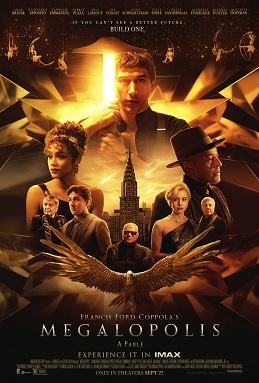
COPPOLA’S DECLINE OF CIVILIZATION
Posted September 24th, 2024 at 6:27 amNo Comments Yet
BLOCKBUSTER

DIRECTOR PULLS INVISIBLE STRINGS TO MAGICALLY BRING ABOUT CHANGE
By PETER THOMAS BUSCH
Director Francis Ford Coppola captures the gently falling fragments of his consciousness in assembling the fable, Megalopolis (2024).
This metaphysical film figurately and literally transcends time and space. The didactic script relies on symbols and metaphors as much as plot lines and character development to tell the story of America’s decline.
Jon Voight and Dustin Hoffman are cast in the film after the two young actors co-starred in the urban dystopia Midnight Cowboy (1969) about two down out players struggling to survive in a ruthless New York City.
In Megalopolis, the much aged players have finally succeeded at the end of their time, but all around them, the city has fallen into disrepair.
Coppola becomes a harbinger for the empire’s downfall, having waited five decades to finally tell the final chapter of the American story now that everything has become so clearly revealed.
Essentially, Americans dressing and acting as if in ancient Roman times preside over the downfall of New York City, I mean the City of New Rome.
Laurence Fishburne provides a voice over while also being cast in the role as the lead character’s aide-de-camp, in a kind of reimagined character composed of all his previous character roles.
The ensemble cast of previous generational and new generational actors make the scenes seamlessly bleed into each other like the revolving lobby doors of a New York City skyscraper. But only one actor gets the opening scenes with omniscient powers.
Adam Driver plays Cesar Catilina, a leading urban architect tasked with building the future of the city. Coppola gives Cesar a few additional powers, like those powers of the director with one all knowing eye looking through the camera, while the other all knowing eye simultaneously reviews the story boards.
Cesar doesn’t have a light saber in his hand. Instead, Cesar has a right angle, levelling ruler with a strange glow about it as the lead architect of the Design Authority.
Coppola accents the film with these self referential acting moments while everyone has already, or will eventually become, unhappy about their individual outcomes. The disaffection grows and grows.
Driver has a moment as William Shakespear’s Hamlet with a famous soliloquy acted out verbatim. And then Driver does another soliloquy a bit more contemporaneously, as part of the current on-screen dystopia.
The film becomes at times a bit like those reimagined Shakespearian plays, but it’s not, because of a lot of Hollywood influences and movie magic behind the fantasy, as well as Coppola’ personal infusion of thought processes.
The film’s motif is more influenced by the fantastical realism of fables and what happens to the magic when those fables get told in Hollywood for the big screen blockbusters.
Cesar has an office in the Chrysler Building far above the battles of good versus evil, while the battles of life and death begin to play out in the City of New Rome.
Shakespearian tropes go by, this way and that way.
Shia LeBeouf plays the son of a city oligarch, Clodio, who denies his struggles with gender dysphoria by suggesting that him dressing in a woman’s toga is a fraternity prank. Clodio eventually dresses as gender neutral to challenge Cesar, his cousin, for political control of the future.
Mayor Cicero, played by Giancarlo Esposito, will not lose out to a street brawl, though. Nathalie Emmanuel plays his daughter, Julia, who also happens to be in love with Cesar. Julia must first win over Cesar her way before swaying her father to side with them.
The father-daughter pairing plays out well among the power politics of civilization.
The families controlling the city are slowly losing their interconnectedness and becoming less and less powerful as disenfranchised fragments, while a younger generation waits not so idly by for an opportunity to succeed.
Emmanuel shows how Julia simultaneously knows this and does not know this, but she is ultimately herself swayed by good to overcome the moral vices.
Those players faulter who attempt to succeed by betraying each other, while loyalty to family prevails.
Coppola uses a rich aesthetic to bind many intellectual layers, like the petals of a flower held together with a lot of fragility.
Roman Catholic themes of confession, crucifixion and resurrection make the script turn this way and that. Driver must at one point bring his omniscient character back from the dead as a way of breaking free from the life and death struggle ever present within human civilization.
The storyline is initially difficult to follow until everyone attends the circus as part of a much more elaborate carnival, during which the individual characters become better revealed and their interconnectedness more obvious.
Coppola suggests, with this fable, that humanity must selflessly participate in a time of great individual and civic sacrifice in the hope that humanity may be able to save civilization from itself.